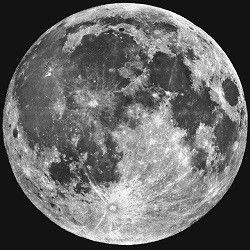"Man In The Moon" Mystery Solved: Scientists Claim It Was Formed By A Massive Volcano
Scientifically Called Oceanus Porcellarum, The Feature Had Intrigued Scientists For Long

"Man in the Moon," is a name given to a giant basin on the moon. The basin when looked at from the Earth resembles the face of a man, and that is why the vast feature has been given the peculiar title. Throughout history several explanations have been given for the "Man in the moon."
According to Mail Online, Early Christians believed that it was the face of a man who was collecting firewood on the Sabbath and was banished due to it. Chinese had their own story attached to the strange face; they thought it to be a face of the goddess who had drank an immortality potion, staring back at them.
BBC News reported that the feature, scientifically called Oceanus Porcellarum had intrigued scientists as well. Researches and studies were conducted to find the origin of the vast feature measuring 1,800 miles. Scientists had previously though that it could have been formed due to a massive asteroid strike. A new research has shown that the basin was not created due to an asteroid strike but due to a massive volcanic eruption.
Researchers used the data from NASA's Gravity Recovery and Interior Laboratory, or GRAIL and found that the basin was not circular as thought to be but in fact it was polygonal in shape. It was not a circle as thought to be, but had straight edges that were inclined at a 120 degree angle, BBC reported.
Geophysicist Maria Zuber, of Massachusetts Institute of Technology, or MIT's Vice President for research stated that if an asteroid had hit the surface, the basin would be circular. The density of the rock revealed that there was a massive lava flow caused by a volcanic eruption.
Researchers explained that soon after the moon was formed, a large plume of molten material with high temperatures from that of the rest of the crust rose from the lunar interior. Since the temperatures differed, there were contractions on the moon's surface and cracks had occurred, causing the formation of what researchers called a "plumbing system" on the moon's crust.
The molten material began moving and spreading across through the cracks, later solidifying. This created the dark pattern that is visible from Earth. It also filled smaller basins causing dark spots.
GRAIL, reported Mail Online, consisted of two spacecrafts that was used, "to determine how where the lunar crust thickens and thins." The high definition maps of the lunar surface were used to analyse the moon's surface.
Though this could be a plausible explanation for the emergence of the Oceanus Porcellarum, the mystery is still not fully solved. Zuber stated that there is no clear explanation as to the how the plume arose in the beginning. He said that it could be a result of "radioactive decay of heat-producing elements in the deep interior," or it could be an impact caused at the early stages of formation. But he states that in the case of the explanation he provided, there is no evidence for such a huge impact.
The study appearsin the journal Nature.





















